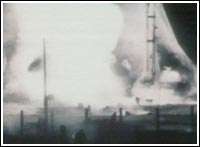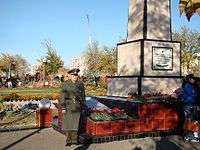Nedelin catastrophe
 The explosion | |
| Native name | Катастрофа на космодроме Байконур |
|---|---|
| English name | The Catastrophe at Baikonur Cosmodrome |
| Time | 18:45 |
| Date | October 24, 1960 |
| Venue | Baikonur Cosmodrome |
| Location |
|
| Also known as | Nedelin disaster |
| Type | Rocket explosion |
| Cause | Short circuit in the rocket |
| Organised by | Soviet Strategic Missile Troops |
| Casualties | |
| 120 injured | |
| Deaths | 78 (92-126 from other sources) |
The Nedelin catastrophe or Nedelin disaster was a launch pad accident that occurred on 24 October 1960 at Baikonur test range (of which Baikonur Cosmodrome is a part), during the development of the Soviet ICBM R-16. As a prototype of the missile was being prepared for a test flight, an explosion occurred when second stage engines ignited accidentally, killing many military and technical personnel working on the preparations. Despite the magnitude of the disaster, news of it was suppressed for many years and the Soviet government did not acknowledge the event until 1989. The disaster is named after Chief Marshal of Artillery Mitrofan Ivanovich Nedelin (Russian: Митрофан Иванович Неделин), who was killed in the explosion. As commanding officer of the Soviet Union's Strategic Rocket Forces, Nedelin was head of the R-16 development program.
Launch preparations
On 23 October, the prototype R-16 was installed on launching pad 41 (Russian: стартовая позиция 41) awaiting final tests before launch. The missile was over 30 m long, 3.0 m in diameter and had a launch weight of 141 tons. The rocket was fueled with Devil's Venom — hypergolic UDMH as the fuel and a saturated solution of dinitrogen tetroxide in nitric acid as the oxidizer — which was used because of the high boiling temperatures and hence storability of the fuel and oxidizer despite being extremely corrosive and toxic. These risks were accounted for in the safety requirements of the launch procedures, but Nedelin's insistence on performing tests before November 7 (anniversary of the Bolshevik Revolution) resulted in extreme schedule pressure, with numerous safety procedures being ignored in order to save time.[1]
Accident
A short circuit in the replaced main sequencer caused the second stage engines, while being tested before launch, to fire inadvertently. This detonated the first-stage fuel tanks directly below, destroying the missile in an enormous explosion. Before attempting refuge, the camera operator had remotely activated automatic cameras set around the launching pad that filmed the explosion in detail. People near the rocket were instantly incinerated; those farther away were burned to death or poisoned by the toxic fuel component vapors. Andrei Sakharov described many details—as soon as the engines were fired, most of the personnel there ran to the perimeter but were trapped inside the security fence and then engulfed in the fireball of burning fuel. The resultant explosion incinerated Nedelin, a top aide, the USSR's top missile guidance designer, and seventy-one other officers and engineers.[2] Missile designer Mikhail Yangel and test range commanding officer survived only because they had left to smoke a cigarette behind a bunker a few hundred yards away.[2][3]
Aftermath
Complete secrecy was immediately imposed on the events of 24 October by Nikita Khrushchev. A news release stated that Nedelin had died in a plane crash and the families of the other engineers were advised to say their loved ones had died of the same cause. Khrushchev also ordered Leonid Brezhnev to head an investigation commission and go to the site. Among other things, the commission found that many more people were present on the launch pad than should have been — most were supposed to be safely offsite in bunkers.
According to Sergei Khrushchev, Brezhnev insisted that the commission punish no one, explaining that "The guilty have already been punished."

Afterwards, Yangel was asked by Nikita Khrushchev "But why have you remained alive?" Yangel answered in a trembling voice – "Walked away for a smoke. It's all my fault." Later he suffered a heart attack and was off work for months.[4]
After the committee presented its report, the R-16 program resumed in January 1961 with first successful flight in November. The delay to the R-16 spurred the USSR toward the development of more effective ICBMs and sparked Khrushchev's decision to install IRBMs in Cuba. Before the disaster Yangel had ambitions to challenge Sergei Korolev as leader of the Manned Space program, but he was directed to focus on the R-16.
A memorial to the victims of the testers was erected in the first half of the 1960s in the Park of Baikonur and is still visited by RKA officials before any manned launch.[5]
Official acknowledgment
A news release stated that Nedelin had died "in a plane crash while on an undisclosed mission."[6][7] The Italian news agency Continentale first reported on December 8, from undisclosed sources, that Marshal Nedelin and 100 people had been killed in a rocket explosion.[8] The Guardian reported on October 16, 1965, that captured spy Oleg Penkovsky had confirmed details of the missile accident,[9] and exiled scientist Zhores Medvedev provided further details in 1976 in the British weekly magazine New Scientist.[10] However, it was not until April 16, 1989, that the Soviet Union acknowledged the events, with a report appearing in the weekly newsmagazine Ogoniok.[11]
See also
- Intelsat 708, the 1990s launch of a satellite by China goes awry and results in the worst space launch disaster since Nedelin.
Bibliography
- Khrushchev, Sergei. Nikita Khrushchev and the Creation of a Superpower. Pennsylvania State University Press, Pennsylvania, 2000. Translated by Shirley Benson. pp 416–425.
- Harford, James. Korolev – How One Man Masterminded the Soviet Drive to Beat America to the Moon. John Wiley & Sons, Inc., New York, 1997. pp 119–120. ISBN 0-471-14853-9
- Chertok, Boris. Missiles and People: Fili-Podlipki-Tyuratam. Moscow, Mashinostroyeniye Publishing House, 1996. (In Russian)
- Chertok, Boris. Rockets and People, Volume 2: Creating a Rocket Industry, 2006. Published by NASA. ISBN 0-16-076672-9
- Sheehan, Neil, A Fiery Peace in a Cold War, Random House, New York, 2009, p 405.
- "Testing of rocket and space technology - the business of my life" Events and facts - A.I. Ostashev, Korolyov, 2001..
- "Baikonur. Korolev. Yangel." - M. I. Kuznetsk, Voronezh: IPF "Voronezh", 1997, ISBN 5-89981-117-X;
References
- ↑ Chapter 32 (Catastrophes), http://history.nasa.gov/SP-4110/vol2.pdf Boris Chertok (author). Rockets and People, Volume 2: Creating a Rocket Industry, 2006, ISBN 0-16-076672-9, Published by NASA
- 1 2 Steve Zaloga, The Kremlin's Nuclear Sword: The Rise and Fall of Russia's Strategic Nuclear Forces, 1945-2000 (Smithsonian Institution Press, 2002) pp 66-67
- ↑ Chris Gainor, Into that Silent Sea: Trailblazers of the Space Era, 1961-1965 (University of Nebraska Press, 2007) p180
- ↑ Первые шаги советской ракетной техники. Статьи. Наука И Техника (Russian)
- ↑ Tsaplienko, Andriy (25 October 2005). Неделинская катастрофа (in Russian). ООО "Интерактивный Маркетинг". Retrieved 9 November 2011.
- ↑ "Milestones", TIME Magazine, November 7, 1960.
- ↑ "Chief of Rockets Killed in Soviet; Moscow Reports Death of Nedelin in Plane Crash", New York Times, October 26, 1960, p2
- ↑ "Rocket Cited in Deaths; Italian Agency Says Blast Killed 3 Russian Experts", New York Times, December 10, 1960, p6
- ↑ "1960 Soviet Rocket Disaster Reported", New York Times, October 17, 1965, p18
- ↑ "Exiled Soviet Scientist Says That an Explosion of Buried Atomic Wastes in the Urals in 1958 Killed Hundreds", New York Times, November 7, 1976, p18
- ↑ "Soviet article reports 1960 launch blast", Pittsburgh Post-Gazette, April 17, 1989, p3
External links
- Nedelin Disaster on RussianSpaceWeb.com
- Video Cosmos
- Nedelin Disaster on aerospaceweb.org
- The Nedelin Catastrophe — article from Air & Space Magazine
- Video clip
- Day when not start missiles. Part one
- Day when not start missiles. Part two
- Memorial
- The newspaper Moskovsky Komsomolets // The disaster at Baikonur (Russian)
- The Russian Union Of Veterans // Day of memory and grief.(Russian)
- The official website of the city administration Baikonur // Baikonur commemorated a test rocket and space technology.(Russian)
Coordinates: 45°58′32″N 63°39′35″E / 45.97542°N 63.65982°E